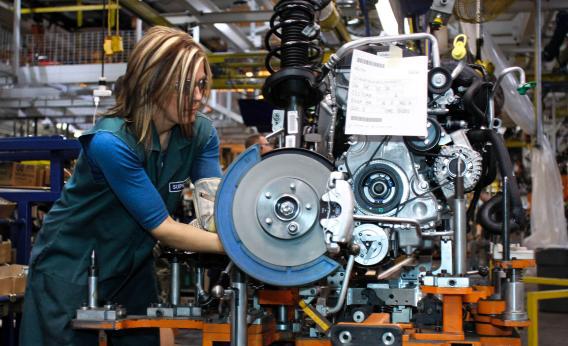It might seem odd for the United States to be running such a large trade deficit amid such high unemployment. One of the main reasons to import goods rather than make them yourself is that by importing goods you free up scarce labor to do other things. But right now we’ve freed up labor to enter the unemployment sector. Bad news.
One potentially useful way of thinking about this is through the calculation Michael Mandel deploys to ask what the economy-wide consequences would be of balancing America’s trade in nonoil manufactured goods (PDF). He thinks it would take 3.5 million to 4 million workers to make the requisite stuff. Potentially that would be a very costly change if it involved 4 million fewer people working in hospitals, schools, and restaurants just to get our hands on material goods that we already have. But unemployment is high. So under present circumstances, he writes that this could “reduce unemployment by about 2.3-2.6 percentage points,” which would be a lot.
However, firms don’t locate production abroad for no reason. They do it because it’s cheaper. So if we relied more on domestically made goods, prices would have to be higher:
In 2011 total gross domestic purchases were equal to $15.7 trillion. Since the added cost to domestic purchasers would be $290-315 billion per year, this would cause a one-time 1.8-2.0% increase in prices at the gross domestic purchases level. In all likelihood, such a large-scale shift from imports back to U.S. production would take years, lessening the sticker shock even more. For example, if it took 10 years to eliminate the trade deficit in this way, the economy-wide inflation rate would increase by about two tenths of a percentage point above what it would have been otherwise.
Mandel thinks this would be a reasonable price to pay to rebuild America’s manufacturing base and get us back into the neighborhood of full employment. And I agree. But I would note that when you try to think clearly about what he’s saying, you see that this idea—like virtually all possible roads back to full employment—crucially depends on the existence of a stimulative monetary policy paradigm. Mandel is assuming that lots of the new manufacturing employment would represent a net increase in employment and not just displace workers from existing jobs. But that’s assuming the Federal Reserve would allow the inflation rate to rise by 0.2 percentage points per year each and every year for 10 years. There’s no indication that the present Fed would in fact do this. Instead, consistent with their policy of capping price increases as a 2 percent annual rate, monetary policy would force net job creation to stay on a low trajectory.
A manufacturing boom would come not at the expense of higher prices and with the benefit of reduced joblessness, but rather at the expense of employment in other industries. At this point all roads to large-scale, rapid reductions in unemployment—whether they involve fiscal stimulus or trade policy or something else—fundamentally depend on cooperative monetary policy. But we don’t have cooperative monetary policy. We have monetary policy that regards mass unemployment as a small price to pay for cheap gasoline, moderate rents, and subdued worker wage demands.
